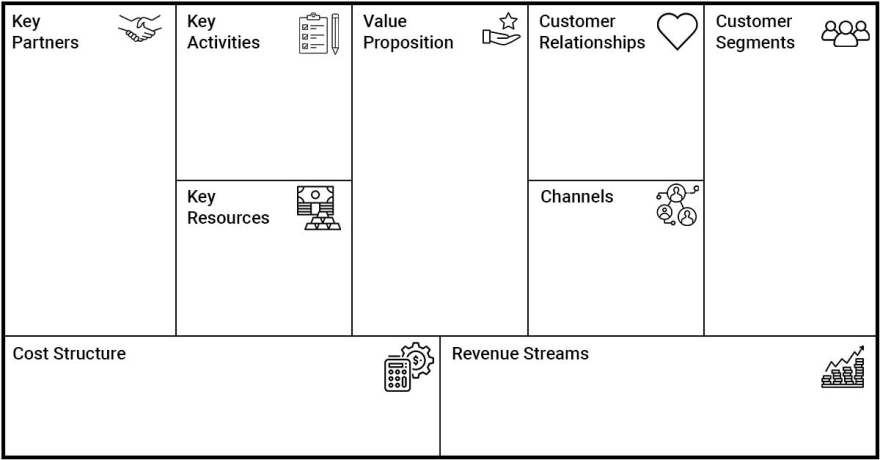So you came up with a product idea and maybe even shared it with your colleagues and some friends. They all told you that it's the best thing they heard about since sliced bread. Perhaps it’s based on your existing business and you noticed another profitable niche.
However, the main question remains - what measurable data do you have to prove the success potential of this product? How do you know if it will be the greatest investment or a hard flop? I will show you how to avoid the mistake of executing a business idea without evidence, regardless of how promising it seemed in the beginning.
Enter Business Model Canvas
It’s great to have a product concept all fleshed out in your entrepreneurial mind, but it has to be structured on paper. To help you with that there is a tool called Business Model Canvas. It's a framework to visualize all building blocks of the business laid out in front of you.
It consists of 9 sections that you have to populate:
- Customer Segments
- Value Propositions
- Channels
- Customer Relationships
- Revenue Streams
- Key Resources
- Key Activities
- Key Partnerships
- Cost structure
Think of them as 9 topics that will give you plenty of points to discuss that you haven’t considered previously. This process will help you come up with an additional value you can provide to your customers, open up new customer segments you haven’t noticed and uncover additional revenue sources.
Here is the Business Model Canvas template which you can print on a large poster and brainstorm with sticky notes or import it in Google Sheets and collaborate with your team online.
Customer Segments
These are your different customer groups. They may be distinguished by different offers, profitability, amount of personalization (think B2B vs B2C), location and demographics.
- Who will be most likely to buy the product?
- Whose problem are we trying to solve?
- Who will get the most benefit from your product?
Value Propositions
This is the core of your product - what value do you bring to your customers? There might be more than one. Make sure you capture every last bit of possible value propositions and then focus on the main ones later.
- What problems are you solving for your customers?
- Which benefits are we offering to each customer segment?
- Will the product be cheaper than competitors?
- Does it emphasize social status?
- Does it reduce risk?
- Is it more convenient?
Channels
The beauty of the modern world is that there are many ways to deliver value to your customers. For example, products targeting on-the-go lifestyle will benefit from mobile apps. More personalized or enterprise products might require person-to-person interaction. Write down all communication, sales and distribution channels in this field.
How are you reaching your customers?
Which channels are cost-effective?
Which channels are less competitive?
How do these channels fit with the customer's lifestyle?
Customer Relationships
For each customer segment, there will be a few ways to grow and sustain the relationship. For an investment management company, the relationship with the customer could start on their website with a questionnaire to create a personalized portfolio. Then send them a welcome email and offer a 1 on 1 session with a financial advisor. However, their B2B department might start the relationship with another business by offering an insightful whitepaper, which will lead to a meeting with a company representative. You have to figure out which type of relationship builders will be most effective for your customers.
What type of relationship is the best for each customer segment?
Which ones are already established?
How costly are they?
Revenue Streams
This is the part where a lot of entrepreneurs either put all of their focus on how they will make money from the product or ignore it and hope that funding will last long enough for the company to become profitable. However, you need to find ways to generate income from your product right away. Think of all possible ways to generate revenue. If you are building software, you could white-label your product and license it to other companies. Create a subscription plan for your skincare products. Get a commission fee from customer referrals.
What do your customers currently pay for?
Which qualities of your product will customers really pay for?
Can you earn additional revenue from partnerships?
How will your customers pay for the product?
Can you license your product?
Can you earn additional revenue from the product community?
How can you price your product so that it's most effective?
Key Resources
These assets are what allows your business to function. It could be your team, real estate, finances, intellectual property or network and connections. This is the part where you have to figure out if you have all the resources available to you. Is there perhaps a weak link that you will need to strengthen?
Who will be constantly looking for new values to provide for your customers?
How much capital is required to support the product?
Do you have access to the required talent?
Does the product require special facilities?
Do you need to license protected intellectual property?
Key Activities
These are the most important actions your team will be taking to make the product successful. Think of them as all the things you need to do to connect previous business model blocks. If your product is a mobile app then your key activities will be developing the software and promoting it. Perhaps it’s connecting customers in a multi-sided marketplace. Doing research and development if you are working on cutting-edge technology.
What do you need to do to deliver value to your customers?
How will you promote the product?
What activities do your revenue streams require?
How will you maintain customer relationships?
If your product is design-centric how will you be showcasing it?
Are you going to be attending trade shows and networking events?
Key Partnerships
As much as this part is self-explanatory, usually, it's overlooked as founders focus on their own company. So many companies could benefit from the network effect that partnerships create. Your partners could open up new distribution channels, revenue streams and reduce costs. Some companies may create a more scalable business model by joining efforts with other teams.
Who are your key partners?
Who are your suppliers?
How much benefit will they bring to your business?
Can you simplify your distribution process through partnerships?
Can you license the product platform before you build your own?
Cost Structure
These are your costs to operate the business model. Look through the processes that will be required to maintain all blocks of the business model. Collect every significant expense item you can come up with. Your Key Activities, Key Resources, and Key Partnerships will incur some costs along the way.
Can you lower costs by outsourcing some activities?
Which activities are most expensive?
How can you reduce their cost?
What costs are most important to the business?
Will the product require a certain scale to be profitable?
Which expenses will provide the most return on investment?
Refine the Business Model
Now that you have completed the first draft of your business model, it’s time to take a customer journey through your business. How do your customers get interested in the product? Is the value obvious to them? Will the product be perceived as valuable enough at your price point? How will you keep the customers engaged? If you can draw a clear customer path then you are already on your way to success. Now it's time to test the model and iterate on its design. Remember that the Business Model Canvas is a living document that will change many times throughout your product development journey. Keep it up to date and relevant, but most importantly immediately accessible by all members of your team.
Conclusion
The Business Model Canvas is an invaluable tool in each entrepreneur’s arsenal. You can create variations of the layout to adapt it to your niche or industry. Add a section with Customer Problems that you are solving. Add intermediate sections between blocks to document how they interact with each other.
You now have a map of your business idea with all key components spelled out. Assess the whole business model for any possible roadblocks or critical errors. If it still looks as promising as it was in your mind, then you are ready for the next step - prototyping and testing your product.
Looking to get started with a business idea? Hire us to help you with product strategy and software development https://www.binarylink.ca/

![Cover image for How to Turn Promising Product Idea Into a Powerful Business Model [Guide]](https://media.dev.to/cdn-cgi/image/width=1000,height=420,fit=cover,gravity=auto,format=auto/https%3A%2F%2Fdev-to-uploads.s3.amazonaws.com%2Fuploads%2Farticles%2Fcjrn5sxxmlusfhlazpu8.jpg)






Top comments (1)
This guide provides an insightful roadmap for transforming a promising product idea into a robust startup business model. By emphasizing the importance of market research, value proposition, and scalability, it offers a comprehensive approach to building a successful startup. The step-by-step process outlined in the article is a valuable resource for aspiring entrepreneurs looking to shape their innovative concepts into sustainable and impactful business ventures.